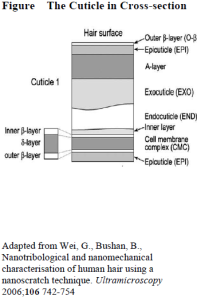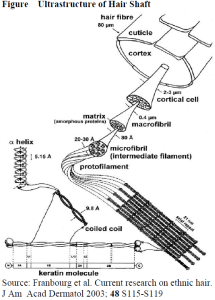Human hair approximately contains 65-95% protein, 15-35% water and 1-9% lipids. The properties of the hair, both physical and chemical, are directly related to these components.
What is Keratin?
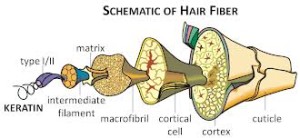
The keratin protein is a helicoidal group of cystine containing protein complexes. Like all proteins, keratin has three basic structures. It has a primary, secondary and tertiary structure. The primary structure is the amino acids that make up keratin and how they are bonded to each other. They are bonded through peptide bonds, disulphide bonds and hydroxide bonds. The secondary structure refers to the arrangement of the protein fibres to each other. Keratin from hair is an alpha protein forming twists which are coiled in an anti-clockwise direction. The tertiary structure refers to the ultimate shape the proteinaceous fibre takes. This is enabled by the presence of weak bonds such as hydrogen bonds.
What is the Primary Structure of Keratin?
Like all proteins, the primary structure of keratin is determined by the amino acid content. The amino acid content of hair is pretty much the same worldwide.
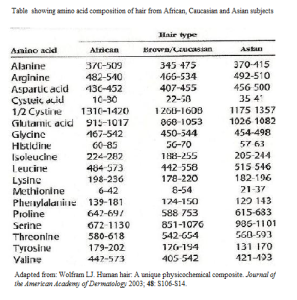
What is the Secondary Structure of Keratin?
The resulting keratin protein is shaped into an alpha-helix, which is held into place by special bonds.

What is the Tertiary Structure of Keratin?
The hair proteins are then coiled together and then bundled into filaments which are further grouped together into larger bundles of filaments.

In between the filaments within the matrix of the cortex lie Keratin Associated Proteins which confer added strength to these filaments. They are bonded to the filaments by disulphide bonds.
What are the bonds that keep the keratin structure together?
The final macromolecular structure of hair is due to the interaction of both intrachain (within chain) and interchain (between chains) bonds which hold the protein filaments together. The interactions are due to several chemical bonds including covalent (disulphide and peptide) bonds, salt linkages, hydrogen bonds, van der Waals forces and hydrogen bonds.
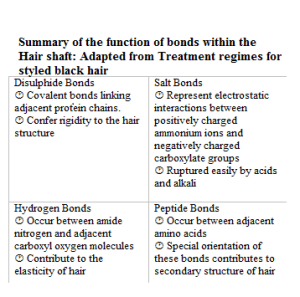

References
Dekio S, Jidoi J. Hair Low-sulfur Protein Composition does not Differ Electrophoretically among Different Races. J Dermatol 1988; 15: 393-6.
Nappe C, Kermici M. Electrophoretic analysis of alkylated proteins of human hair from various ethnic groups. J Soc Cosmet Chem 1989; 40: 91-9.
Dekio S, Jidoi J. Amounts of Fibrous Proteins and Matrix Substances in Hairs of Different Races. J Dermatol 1990; 17: 62-4.
Baden HP. Biochemistry of hair protein. Clinics in Dermatology 1988; 6: 22-5.
Shimomura Y, Ito M. Human Hair Keratin-Associated Proteins. J Investig Dermatol Symp Proc 2005; 10: 230-3.
Draelos MD, Zoe Diana (2007-04-17). Hair Care (Kindle Locations 331-333). Informa Healthcare. Kindle Edition.
Sources of Diagrams
intranet.tdmu.edu.ua
hairkeratins.com
teachers.yale.edu



